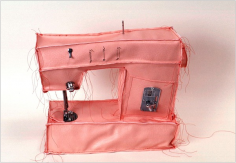Margarita Cabrera
source: margaritacabrera
My work continues an ongoing exploration of the defining economic and cultural relationships between the United States and Mexico. I am interested in creating an aesthetic platform for political and social-cultural consciousness as a means of survival. Many immigrants are living in constant fear of deportation don’t have the option to travel outside of the US for fear of not being allowed re-entry. They are missing a connection to their ethnic lineage, don’t speak Spanish, and many of them don’t know where their family’s come from. Anchored in no-man’s land, I see them as dislocated and incomplete on a physical and emotional level.
The work is titled “Cultural Prosthetics.” Similar to medical prosthetics, which are artificial extensions that replace missing body parts typically lost by trauma, congenital parts or replacing defective body parts, “Cultural Prosthetics” metaphorically provide enhancement of motor control in the form of physical and emotional cultural equilibrium.
Art workers are real workers with real jobs who are part of this country’s real economy in the same way that these students and many immigrants participate. In addition to providing jobs, the workshops will also introduce a traditional cultural craft connecting immigrants and migrants to their native country through a cultural/ethnic art making experience.
With regard to the craft of basketry as a way to make the prosthetics, I will be working with the Tarahumara Indians of Copper Canyon, Mexico. They are a large indigenous group which navigates between their traditional Raramuri lifestyle and the other which integrates more with the Christian Mexican culture. Much like immigrants in this country, they live in a space in between cultures where they fight hard to be able to continue their traditional crafts, preserve their cultural roots and dignity as they work to provide for their families.
.
.
.
.
.
.
.
chicanaartblogspot
Margarita Cabrera is an artist whose work I was familiar with despite me not remember her name. That is, until now. It was a pleasant surprise to see her soft sculptures once again. The materiality of her work is simplistic, but has a very powerful message stitched on it’s surface. In connection to Cabrera’s social commentary on the labor production, I could not stop thinking how much her sculptures reminded me of a child’s toy. The soft sugary pink hues of the sewing machine (left) quickly identify this as a young girl’s toy.
Not limited to a sewing machine, Cabrera’s sculptures also explore other domestic appliances. The sunbeam glow of her yellow coffee maker (right), which I found when researching the artist’s work further, immediately confirmed my thoughts that these sculptures could also be toys. I was taken back to my sister’s Easy Bake Oven (bottom right), that she received as a gift from a family member. The color of Cabrera’s sculpture suddenly became a cautious yellow, warning it’s viewer. Although seemingly harmless, these toys perpetuate gendered norms for young girls, luckily it turns out my sister is not a very great cook after all.


